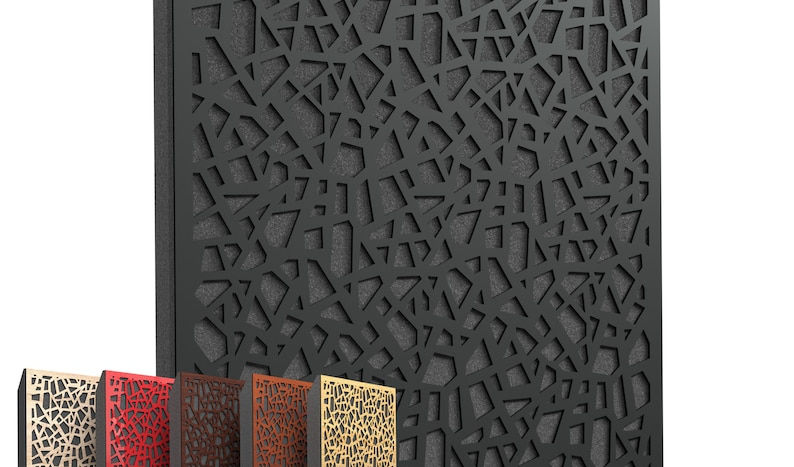

Learn how modern acoustic solutions can not only improve sound quality in indoor spaces, but also increase the well-being and productivity of users.
Interior acoustics
Why is interior acoustics important?
Well-being and health: Good room acoustics contribute significantly to well-being. Poor acoustics can lead to stress, fatigue, and concentration problems.
Productivity and efficiency: In work environments such as offices or conference rooms, optimized acoustics can increase productivity by improving concentration and communication.
Sound quality: In spaces like music studios, theaters, or concert halls, good acoustics are crucial for sound quality. They ensure that the sound is clear and balanced.
Reduce noise pollution: Good acoustics help minimize disturbing noises, which is especially important in living spaces and public facilities.
The acoustic requirements vary depending on the different functions of rooms. However, the fundamental goal is always to influence the interaction of sound with the room on its journey from transmitter to receiver.
Sound in the room
Sound spreads from the source in all directions throughout the room. There is a direct path to the receiver, unobstructed by any obstacles. We cannot influence this path unless we separate the room and completely prevent this type of transmission. Where we can exert significant influence in architecture, however, is indirect sound, which is reflected or transmitted through structural elements. We distinguish between the following interactions of sound in a room:
Sound reflection
When sound waves hit surfaces such as walls, ceilings, or floors, they are reflected. Smooth, hard surfaces amplify the reflection, which can lead to echoes and a loud background noise.
Textured or curved surfaces don't directly reflect sound waves back, but rather disperse them throughout the room at a reduced intensity. Elements designed for this type of sound reflection are called diffusers. Depending on the geometry, they can even prevent the sound from being reflected back at all, allowing it to be lost in the geometry.

Sound absorption
Materials that absorb sound waves prevent reflection and reduce the volume and echoes in the room.
The more surfaces are covered with sound-absorbing materials, the lower the proportion of reflected sound waves. In extreme cases, this effect can create a so-called anechoic chamber.

Sound transmission
Sound can also be transmitted between rooms or through walls, which can be problematic in apartment buildings or offices.
In particular, lower tones (bass) are transmitted more easily due to the higher energy.

Challenges in interior design
In most cases, the problem with interior design is that background noise impairs the acoustic quality of the room. This is especially true in communal spaces such as restaurants, open-plan offices, shops, or schools. But overly reflective surfaces and the resulting echo are also disruptive in private living spaces.
In interior design, we have various options for addressing this problem. In addition to changing the geometry, we also have the option of using different materials. The absorption capacity of the materials plays a particularly important role here.
Thoughtful acoustic planning creates spaces that are functional, comfortable and aesthetically pleasing at the same time.

Material and sound
At the microscopic level, the material determines the surface structure that the sound hits.
In general, the softer and more porous a material is, the better its ability to absorb sound. It's important to note that sound waves are absorbed differently depending on their wavelength. Low tones (bass) in particular are more difficult to absorb and are often reflected back and forth across a room multiple times.
Common materials for sound absorption include:
mineral wool
This is often used in acoustic panels and suspended ceilings and offers excellent sound-absorbing properties. The thicker the layer of mineral wool, the better it absorbs lower tones.

foam
Acoustic foams are available in various densities and shapes and can be used in the form of panels or sheets. Because these are specifically designed for sound absorption, they often have a characteristic corrugated surface, which also enhances their geometric absorption capacity.

textiles
Special acoustic curtains and furniture coverings are made of sound-absorbing materials. Textiles are often used in combination with other absorbing materials, such as upholstery.

Felt/Wool
Sheep's wool is an effective and environmentally friendly material for improving indoor acoustics. Its sound-absorbing properties and additional benefits such as moisture regulation and thermal insulation make it an excellent choice for acoustic applications.

cork
Cork is a natural sound insulator and can be used as flooring or wall covering.

Technologies in focus: Combining acoustics and design
With modern technologies, architects can design spaces that harmoniously combine function and aesthetics.
-
Custom-designed acoustic panels: combining design and function.
-
Integration into furniture: Acoustic elements that are part of the furnishings.
-
Digital planning tools: Simulations that make acoustic results visible already in the planning phase.

Application examples
contact
Next topic









